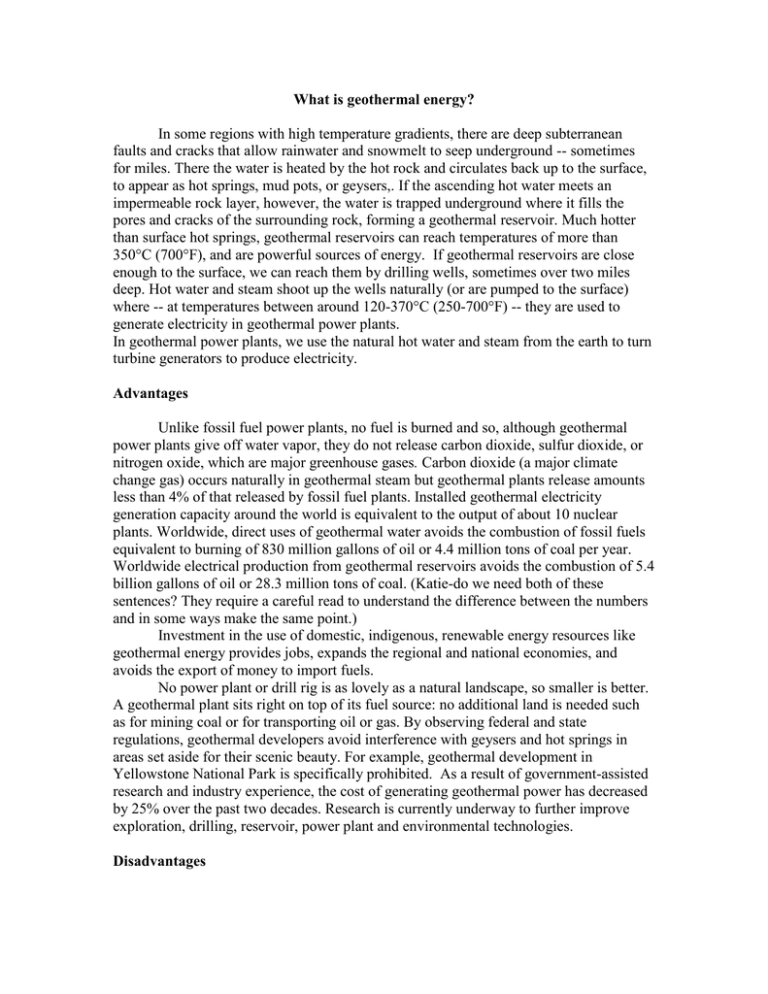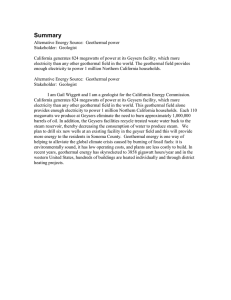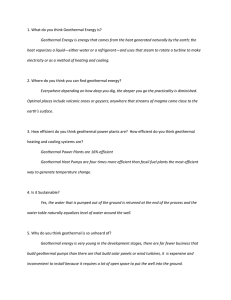What is geothermal energy?
advertisement

What is geothermal energy? In some regions with high temperature gradients, there are deep subterranean faults and cracks that allow rainwater and snowmelt to seep underground -- sometimes for miles. There the water is heated by the hot rock and circulates back up to the surface, to appear as hot springs, mud pots, or geysers,. If the ascending hot water meets an impermeable rock layer, however, the water is trapped underground where it fills the pores and cracks of the surrounding rock, forming a geothermal reservoir. Much hotter than surface hot springs, geothermal reservoirs can reach temperatures of more than 350°C (700°F), and are powerful sources of energy. If geothermal reservoirs are close enough to the surface, we can reach them by drilling wells, sometimes over two miles deep. Hot water and steam shoot up the wells naturally (or are pumped to the surface) where -- at temperatures between around 120-370°C (250-700°F) -- they are used to generate electricity in geothermal power plants. In geothermal power plants, we use the natural hot water and steam from the earth to turn turbine generators to produce electricity. Advantages Unlike fossil fuel power plants, no fuel is burned and so, although geothermal power plants give off water vapor, they do not release carbon dioxide, sulfur dioxide, or nitrogen oxide, which are major greenhouse gases. Carbon dioxide (a major climate change gas) occurs naturally in geothermal steam but geothermal plants release amounts less than 4% of that released by fossil fuel plants. Installed geothermal electricity generation capacity around the world is equivalent to the output of about 10 nuclear plants. Worldwide, direct uses of geothermal water avoids the combustion of fossil fuels equivalent to burning of 830 million gallons of oil or 4.4 million tons of coal per year. Worldwide electrical production from geothermal reservoirs avoids the combustion of 5.4 billion gallons of oil or 28.3 million tons of coal. (Katie-do we need both of these sentences? They require a careful read to understand the difference between the numbers and in some ways make the same point.) Investment in the use of domestic, indigenous, renewable energy resources like geothermal energy provides jobs, expands the regional and national economies, and avoids the export of money to import fuels. No power plant or drill rig is as lovely as a natural landscape, so smaller is better. A geothermal plant sits right on top of its fuel source: no additional land is needed such as for mining coal or for transporting oil or gas. By observing federal and state regulations, geothermal developers avoid interference with geysers and hot springs in areas set aside for their scenic beauty. For example, geothermal development in Yellowstone National Park is specifically prohibited. As a result of government-assisted research and industry experience, the cost of generating geothermal power has decreased by 25% over the past two decades. Research is currently underway to further improve exploration, drilling, reservoir, power plant and environmental technologies. Disadvantages Geothermal energy production is not practical everywhere. It works only if there is sufficient heat, permeability, and water in a system, and if the system is not too deep. The available heat cannot be increased, but the permeability and water content can be enhanced (Katie, not sure what this last sentence means). The possibility for using geothermal energy use depends on at least three factors: the demand for energy in general, and therefore how expensive are fossil fuels; the inventory of available geothermal resources; and the competitive position of geothermal among other energy sources. Geothermal energy only occurs in specific locations and may not be able to produce enough power to replace fossil fuels. Using current technology geothermal energy from already-identified reservoirs can contribute as much as 10% of the United States energy supply. Like many renewable resources, geothermal resources need relatively high initial investments to access the heat, hot water and steam (Katie—might be good if we could find some specifics here about initial costs).








